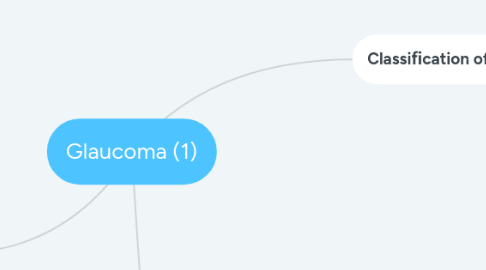
1. :Risk factors of glaucoma:Family history of glaucoma Age 60 and older. Eye injury , certain eye surgeries or chronic eye inflammation. Diabetes, high blood pressure, heart disease or hypothyroidism steroids for long periods of time . Asian-American descent – this puts you at increased risk for angle-closure glaucoma
2. Classification of the glaucomas
2.1. 1. Primary glaucoma: Chronic open angle. Acute and chronic closed angle
2.1.1. chronic open angle glaucoma: open angle glaucoma the trabecular meshwork appears normal on gonioscopy but functionally, it offers an increased resistance the outflow of aqueous
2.1.1.1. Risk group:: 1)) Affects 1 in 200 of population over the age of 40. 2)) Males and females are equally affected. 3))There maybe family history but the exact mode of inheritance is not clear. 4)) Myopic patient
2.1.1.2. It causes SLOW damage to the optic nerve, causing gradual loss of vision.( because of the gradual inc. in pressure) *The patient FIRST loses the peripheral visual field then it progress to total blindness if left untreated
2.1.1.3. Symptoms: 1) Because the vision loss is gradual, usually Bilateral and asymmetrical the patient usually present when severe damage has occurred & Its painless. 2) sign is disc cupping . 3) Visual field defect: Gradual loss of peripheral vision, usually in both eyes, Tunnel vision in the advanced stages.
2.1.1.4. POAG criteria: (you need 2 out of 3) 1.IOP 2.Visual field changes 3.Optic nerve damage (cupping)
2.1.1.5. For the diagnosis : 1) Gonioscopy 2)Visual field test 3)Direct ophthalmoscope for the cupping
2.1.1.6. Management: **Aim of treatment is to decrease the IOP ** Amount of decrease depends on the level at which no more damage to the optic nerve happens . *This level differs from patient to other *Modalities : 1- Medical Treatment 2- Laser Treatment A) Trabeculoplasty : open meshwork ( used in open angle ) B) iridotomy : open hole in iris ( uses in closed angle ) 3- Surgical Treatment by make an opening to drain the aqueous humour ( Bypass shunt )
2.1.1.6.1. Medical treatment : Topical eye drops (five families): 1.Prostaglandins analogues ,Latanoprost (1st line of Rx) 2.B-blocker , Timilol (2nd line of Rx) contraindicated in asthma (.we can use bate 1 selective but with caution in asthmatic patient.) 3.Carbonic anhydrase inhibitors ( Dorsolamide ) 4.Alpha 2 agonist 5.Cholinergic agonist
2.1.2. Acute & Chronic Angle Closure Glaucoma
2.1.2.1. RF: Hypermetropia / small eye / Female
2.1.2.2. PresentationPresentationed vision / headache / photophobia/ Nausea aned vision / headache / photophobia/ Nausea anmid fixed dilated pupil / increase IOP / c
2.1.2.3. Investigation Gonioscopy/ Slit lamp
2.1.2.4. Urgent Treatment is necessary All efforts to decrease IOP For the acute attack : -IV/oral acetazolamide. If nausea and vomiting are not tolerated switch to manitol. -Topical anti-glaucoma (Pilocarpine, B-blockers) - Painkiller For prevention of subsequent attacks: Laser ( iridotomy ) Surgery (iridectomy )is the main step in treatment. Prophylactic to the fellow eye.
2.1.2.5. Symptoms : 1. The eyes becomes red and painful due to rapid increase in IOP & ischemic tissue damage. 2. Blurred vision; because the cornea becomes edematous. 3.Patient may notice haloes (circles of light(rainbow)) around light due to dispersed light in waterlogged cornea. 4. Headache 5. Nausea and vomiting due to vagal stimulation 6. Photophobia.
2.1.2.5.1. Sings :1) Red eye 2) Increase IOP . 3) mild dilated fixed ( reacted poorly to the light) pupil 4) shallow anterior chamber 5) Cloudy cornea
